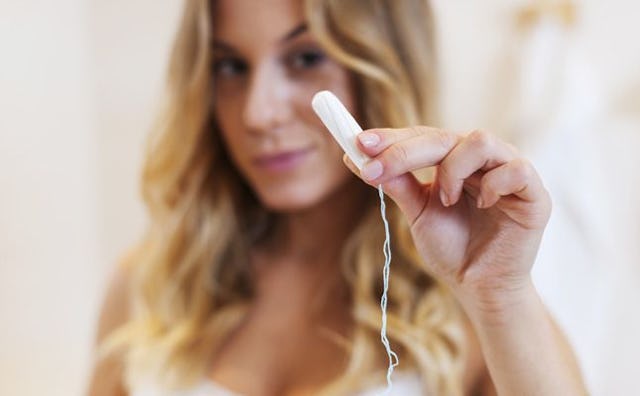Going Green On Your Period

I recently got my period while shopping in an organic grocery store. How convenient, I thought, I’ll just pop on over to the feminine hygiene aisle and pick up some lady products.
But there I stood, incredulously, perplexed by the otherworldly options. Reusable rags, Mooncups, chlorine free, perfume free, plastic free, bleach free, 100% organic cotton pads and non-applicator tampons, sea sponges, leak-free bamboo fiber panties, soaking containers for aforementioned reusable rags, stain and odor eliminators made with plant-derived ingredients, and a practical guide to alternative menstrual products.
RELATED: 8 Effective Ways To Remove Period Blood Stains From A Mattress
My eyes briefly wandered over to the “sex” shelf, and I caught a glimpse of gluten-free lubricant. Apparently, vaginas can be vegan! Astonished, I tossed a package of “natural” pads in my cart—baby steps into the world of environmentally friendly menstruation—and made a beeline for the bathroom.
The pads were not individually wrapped. Right off the bat, I found this problematic. How can you be discreet with an unwrapped sanitary napkin the size of your forearm? What if you wanted to go out to a fancy dinner and you needed to bring backup? Do you roll the mattress-sized maxi pad into eco-friendly plastic wrap alternative and stuff it in your clutch, or do you carry it around in a brown paper bag? Surely they must make pads with biodegradable wrapping; maybe I just grabbed the super save-the-earth kind by mistake.
I pulled off the adhesive backing and tried to stick it to my high-waisted briefs, but without the carcinogenic industrial glue, it wouldn’t stay put. I cautiously straddled the cotton pony and waddled out to the produce section to pick up some non-GMO potatoes for dinner. When I got to the checkout line, I prayed that my wood pulp-and-wheat feminine protection didn’t fall out on the floor. Greening your period takes a lot of effort y’all!
Maybe the cup or sustainably harvested sea sponges would be better options, but I don’t like the idea of reaching around my crimson vagina to suction a miniature silicone cup around my cervix. What happens when your cup runneth over? What if it gets lost in your vagina? What do you do with the blood in the cup? And, what are sustainably harvested sea sponges anyway? Is a sea sponge a plant from the ocean floor, or is it a sea urchin? I’ve put some questionable stuff in my vagina, but I draw the line at sea urchins. I mean, why not just shove a piece of kale up there?
To add to the confusion, I don’t know what size I am for these medieval contraptions. Did you know that vaginas come in sizes? I’m five foot two; does that mean I have a short vagina? How does one confirm vagina size? How could I have lived this long not knowing if I have a long or short vagina!?
And how about the rag recyclers of the world? They’re hardcore. They are probably the same women who home birth, home school, and make homemade baby food. I admire these women, but I’m not cut from the same cloth as they are. I can barely manage laundry, so how could I possibly be held responsible for soaking, stain lifting, washing, and reusing my bloody rags? I already separate my plastics for recycling. Isn’t that good enough?
I do feel a little guilty about my failed menstrual duties to mother earth. How many non-biodegradable plastic tampon applicators and artificially fragranced overnight pads with flexi wings have gotten dumped in landfills? How many more cycles do I have left, and if I change my ways now, will it be enough to save the planet? I’m afraid I’m finding out about this green period movement too late.
This whole thing feels overwhelming, barbaric, and witch crafty. Maybe I just won’t leave the house for five days every month. Better yet, maybe my husband can build me a menstruating hut complete with a wet bar, WiFi, and A/C. I can keep my uterine pollution to myself, reduce my carbon footprint, and get a break from doing the dishes.
This article was originally published on